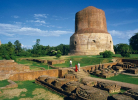
History of Varanasi
This continuously inhabited city, home to hindu scriptures dating 11th century B.C. is a living example of harmony with around 200 temples including the world famous “Kashi Vishwanath”.
Originally called Kashi it is also called by several other names like Anandakanana, Mahashamshana, Sudarsana and Avimuktaka. Its present name “ Varanasi” has been derived from Varuna and Asi – two tributary rivers of Ganges.
As per historians Varanasi used to be the main nucleus of Aryan religion. It was during the rule of Aryans that it flourished as commercial as well industrial hub. In 6th century, Benaras evolved as capital Kingdom of Kashi. It was during this time only that Lord Buddha delivered his first sermon. Even Chinese traveler who visited Hsuan Tsang in AD 635 said a lot about Varanasi in his descriptions.
However, Varanasi saw a tough phase under Muslim rule for around three decades. It was in 16th century that under the rule of Mughal Emperor Akbar things were restored. 18th century saw a lot being done as Varanasi became an independent Kingdom.
Ramnagar became the capital in the year 1910 under British rule. After India’s independence it became a part of present Uttar Pradesh.
Presently thousands of tourists both Indian and foreigners reach here to take the blessings of highly revered river Ganges.










